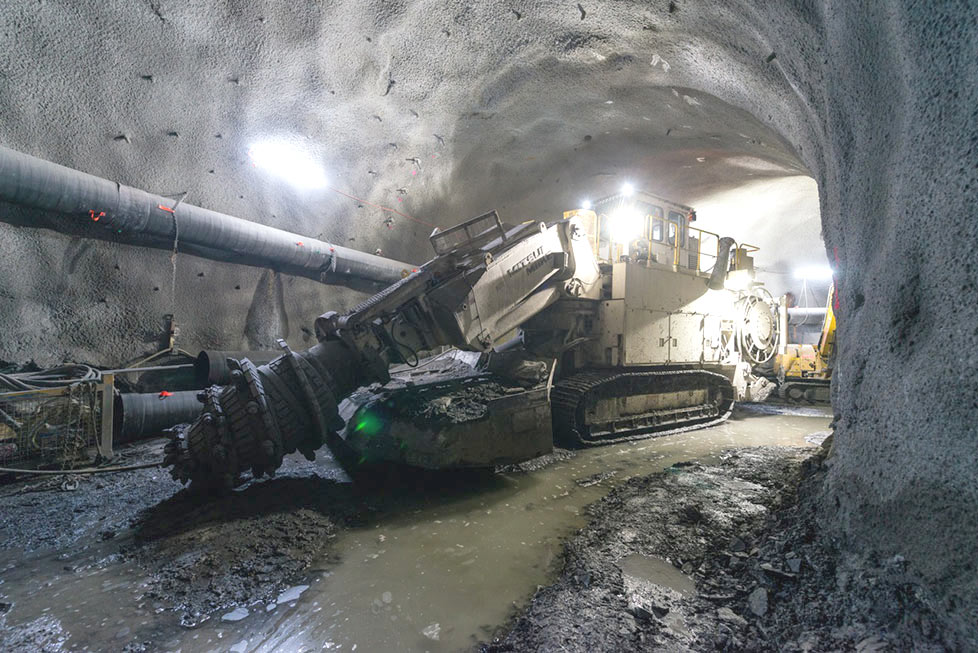Training roadheader operators in Sydney 31 Aug 2016
With road tunnelling work on the NorthConnex and the WestConnex M4 East and New M5 contracts all due to start at several locations simultaneously across Sydney within the coming years, operators of roadheaders will be in high demand. As a result, the M4 East contract JV of CPB Contractors, Samsung and John Holland (CPBSJH) has developed an Australian training first to ensure skilled operators are available to meet the need.
Thirteen of the 18 roadheaders set to work on the M4 East project and starting from this year, are being fitted with new operator cabins, which will allow for dual occupation. Up to now, roadheaders in Australia have been single seat cabins. The new modified cabins are about 50% larger and are designed to allow new operators to train during operations.
About 40 operators will be needed to maintain roadheader excavation on the 24hr/day, 7 day/week M4 East contract production schedule. About half of these will need some level of training.
The cab modification was the idea of the M4 East construction team. The CPBSJH JV crews have worked on many of Sydney’s tunnelling projects over the last 20 years and identified an innovative solution for a particular challenge. An Australian based company was chosen to design and manufacture the larger cabins and in compliance with Australian standards.
“With tunnelling for the M4 East coinciding with other tunnelling projects in Sydney, and a shift in demand from mining to infrastructure, it is vital that we have the skilled operators required to meet our construction timelines,” said CPBSJH Plant Manager Mark McLean. “While it has not been done before, modifying the cabins for training meant we could consider other innovations in design, including improved visibility, increased structural integrity, a significant reduction in noise and vibration, as well as fully ergonomic seat adjustments.
“With these improvements, the Japanese roadheader manufacturer we have been working with is now considering the dual cab as a potential export standard for all new machines,” said McLean.
The opportunity to upskill to a roadheader operator will be open to operators of machines from other industries, particularly those with a background in mining. They will learn from CPBSJH tunnel superintendents with combined total of more than 90 of combined tunnelling experience.
WestConnect Project Director Terry Chapman said the training opportunity would open up long term opportunities with more tunnelling projects forecast across Sydney. “The M4 East is the first tunnel section of WestConnex, and will be followed by the New M5 and the M4-M5 Link,” he said (Fig 1).
“In addition, as part of the Government’s integrated transport program, plans are progressing for Sydney Metro, including a new rail tunnel harbour crossing, in addition to the proposed Western Harbour Tunnel, which will eventually connect to WestConnex and provide a much needed second road crossing of the harbour. On the job training now will provide skill development for future employment opportunities stemming from these critical infrastructure projects,” said Chapman.
M4 East roadheader and tunnelling facts
- Eighteen roadheaders will be used to construct the M4 East twin tunnels, consisting of three refurbished roadheaders and 15 new units
- Thirteen roadheaders are being fitted with new dual cabins, which will be 50% bigger than a single cabin and feature several innovations for increased safety and comfort and allow for on-the-job training of new operators
- Roadheader excavation will progress from four tunnelling sites for the M4 East contract
- Average tunnel depth will be 35m with the top of the tunnels at the deepest point about 50m below ground level
- Roadheader excavation will be mainly through Hawkesbury Sandstone and through some Ashfield Shale
- Excavation will generate about 1.7 million m3 of spoil
- More than 600 people are expected to work underground during construction including up to 40 roadheader operators
References
- First tunnel award for Sydney WestConnex – TunnelTalk, 10 June 2015
- Sydney NorthConnex roadheader award – TunnelTalk, 8 July 2015
|
|
|
|
|
Add your comment
- Thank you for taking the time to share your thoughts and comments. You share in the wider tunnelling community, so please keep your comments smart and civil. Don't attack other readers personally, and keep your language professional.







